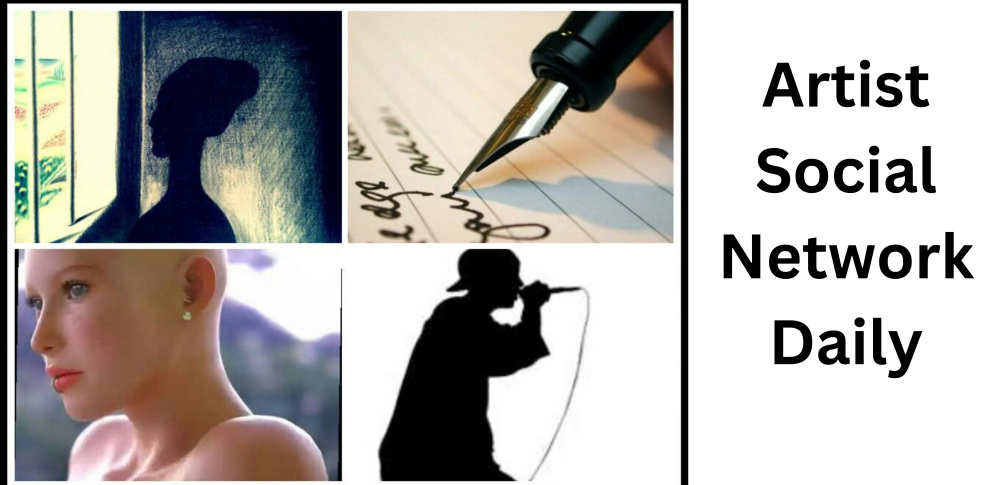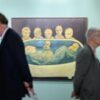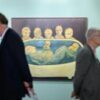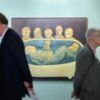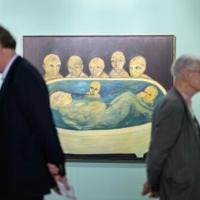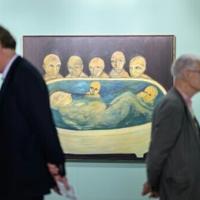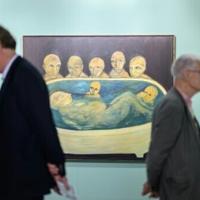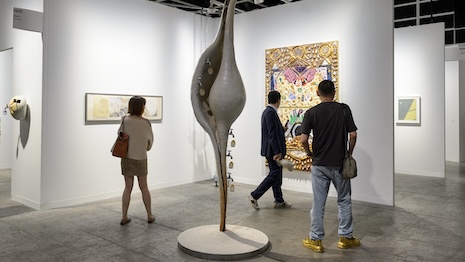 Collectors from more than 70 countries attended Art Basel Hong Kong 2025 this past March. Image credit: Art Basel
Collectors from more than 70 countries attended Art Basel Hong Kong 2025 this past March. Image credit: Art Basel
The United Kingdom has regained its position as the second-largest art market internationally, overtaking China for the first time since 2020, according to the newly released Art Basel and UBS Global Art Market Report 2025.
Worldwide, art sales reached an estimated $57.5 billion in 2024, down 12 percent year-over-year, though transaction volumes increased by 3 percent. Heightening activity in lower price tiers and growing interest from new buyers appear promising.
“Despite geopolitical and economic uncertainty, the latest Art Basel and UBS Global Art Market Report 2025 reaffirms the U.S.’s enduring position as the world’s largest art market, accounting for 43 percent of global sales by value,” said John Mathews, head of private wealth management for the Americas at UBS, in a statement.
“The uncertainty in the U.S. market should ease as the U.S. economy settles,” Mr. Mathews said. “While the art market is experiencing a turning point, the U.S. remains the largest center of high-net-worth wealth with collectors remaining active in the art market.”
For the report, Art Basel and UBS commissioned cultural economist Dr. Clare McAndrew of independent research and consulting firm Arts Economics, who sourced insights from dealers, auction houses, art fairs, art and antique collectors, art price databases, financial and economic databases, industry experts and others involved in the art trade and its ancillary services. Arts Economics also used findings from two surveys distributed to auction houses, including a comprehensive top-tier survey of the top 10 global auction houses and second-tier survey of around 500 national auction houses.
Global Art Market Report 2025
Authored by Dr. McAndrew, the publication shows that last year delivered notable changes at the top end of the market.
Broken out by region, the United States maintained its lead as the most lucrative global art market, garnering $24.8 billion and representing nearly half of the industry’s annual sales in 2024, though it still experienced a year-over-year decline to the tune of 9 percent.
Down 5 percent, the U.K. accounted for 18 percent of all sales, totaling $10.4 billion, while China’s share fell to 15 percent, or $8.4 billion, after a 31 percent drop in sales. France held steady in fourth place, with $4.2 billion in sales and a 7 percent global share.
Online art sales dipped 11 percent to $10.5 billion, though platforms managed directly by dealers saw a proportional rise in use.
Dr. McAndrew joins Art Basel CEO Noah Horowitz; UBS Global Wealth Management Global Equities CIO Ulrike Hoffmann-Buchardi; and Paula Cooper Gallery senior partner Steve Henry during a panel discussion on the annual report
As far as market drivers are concerned, a bump in revenues from purchases of works under $50,000 helped sustain dealer and auction house performances, with the report noting that increased engagement with accessibly-priced art drove momentum for both parties.
New buyers comprised 44 percent of dealer clientele in 2024. Female artists also fueled modest gains and represented 41 percent of works offered by dealers, up 6 percent from 2018.
“While the market has declined in value for two years, one of the most positive developments has been the growth of sales at the lower and more affordable prices,” said Dr. McAndrew, in a statement.
“The number of artworks sold for prices in the sub-$50,000 range has expanded and there has been evidence of success by both dealers and auction houses in reaching new buyers, giving the market a broader and more diversified base for sales,” she said. “Continuing to expand the market to wider audiences, including through the relatively unencumbered exchange of art across borders, will remain essential to its long-run growth.”
Business outlook
Per the report, art fairs remained critical touchpoints in 2024, cited as the top source of new buyers by 31 percent of dealers.
“While one of the key themes in 2024 was the continued easing of the high-end of the market amid economic and geopolitical uncertainty, and shifting collector behaviors, new buyers nevertheless made their presence felt, sales volumes accelerated and transactions at art fairs ticked up,” said Noah Horowitz, CEO of Art Basel, in a statement.
“These trends reflect the urgency of expanding networks and dedicated audience engagement strategies across the spectrum in order to adapt and thrive within today’s business environment,” Mr. Horowitz said. “Our most recent edition of Art Basel Hong Kong (see story) reaffirmed this to start 2025 with strong sales and engagement from both existing and new audiences across Asia and worldwide – dynamics that we will monitor closely as the year gathers pace.”
In 2023, China overtook the U.K. in UBS and Art Basel’s ranking (see story); a rocky economy persisted, impacting its standing last year. Market performances across Asia varied in 2024, though Japan managed to grow its art sales figures by 2 percent year-on-year.
“Most developed economies achieved a soft landing in 2024, and from an economic perspective, the outlook should be one of continuity,” said Paul Donovan, chief economist at UBS Global Wealth Management, in a statement.
“However, politics introduce uncertainty, with the shift toward economic nationalism bringing trade protectionism, restrictions on labor movement and limits on capital flows,” Mr. Donovan said. “Amid the great wealth transfer and shifts in the global economic landscape, we are witnessing a turning point in the art market.”
While big-name dealers are known to operate more exclusively, firms are comprehensively reporting that a significant portion of their recent buyers are new recruits, signaling opportunity. Looking ahead, 80 percent of dealers expect stable or improved sales in 2025, with confidence strongest for works costing between $500,000-$1 million.
“The market’s ability to adapt and attract new buyers underscores its enduring appeal,” said UBS’ Mr. Donovan, in a statement. “While economic change can be daunting, it also creates new opportunities.”
This post was originally published on this site be sure to check out more of their content
